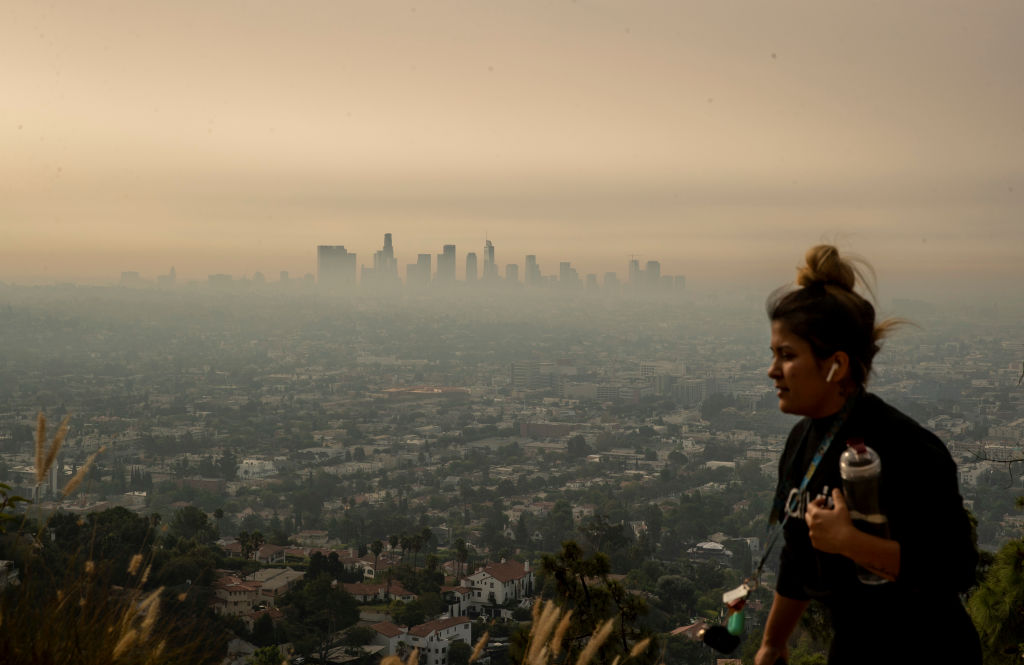
Climate change is transforming air pollution in the U.S., driving an increase in hazardous high-pollution days in Western states., even as environmental regulations help to clean up traditional sources of contaminants nationally. That’s the picture from a report released Wednesday by the nonprofit American Lungs Association (ALA).
The ALA first began publishing annual air quality data—recorded at thousands of monitoring stations around the country—back in the early 2000s, examining ozone (or, smog), a key culprit in breathing difficulties, and fine particulate matter, exposure to which is correlated to eye irritation, heart problems, and a range of cancers. Since then, year-round levels of both forms of pollution have been falling, as cities feel the impact of higher standards for cars, power plants, and factories under the Clean Air Act and other legislation.
But at the same time, increasingly frequent heat waves and wildfires, particularly in western parts of the country, have driven up the number of days where pollution spikes dangerously. In the three years to 2021—the period examined by the report—U.S. counties experienced a record 113 “very unhealthy” days and 73 “hazardous days.” That’s compared to fewer than nine of the former and none of the latter each year in the first decade of reporting.
“All the controls we’ve put in over the last 50 years to clean up the air are showing benefits,” says Katherine Pruitt, ALA’s national senior director of policy and the report’s author. “But [greenhouse gas emissions] are not under control, and that’s starting to undermine the progress we’ve been able to make.”
The new pattern in air quality—an increase in dangerous pollution spikes locally despite long-term national improvements —is reflected in a significant drop in the overall number of people exposed to unhealthy air last year. ALA finds that 119.6 million people now live in counties with failing grades for year-round levels of ozone or particle pollution—17.6 million fewer than in the previous year’s report. At the same time, however, the number of people living in counties with failing grades for daily spikes in particle pollution was the highest in a decade at 63.7 million.
A version of this story also appears in the Climate is Everything newsletter. To sign up, click here.
Western states are bearing the brunt of sudden climate change-linked drops in air quality. Of the 25 cities with the worst spikes in daily pollution, 23 were in the Western U.S., with Bakersfield, Calif., Fresno-Madera-Hanford, Calif. (a combined statistical area), and Fairbanks, Ala., leading the pack.
The great difficulty posed by this new era of air pollution is illustrated by California, which makes up 10 of the 25 counties most affected by daily spikes. The state has enacted some of the nation’s most stringent rules on both air quality and the greenhouse gas emissions that cause climate change. But with its fast-warming climate, years-long droughts, and fire-prone forests, Pruitt says the state is “perfectly poised” to suffer dangerous short-term pollution spikes.
Alongside the widening pollution gap between East and West, older inequalities persist. People of color are 3.7 times as likely as white people to live in one of the counties with a failing grade for all three categories ranked by the ALA report (ozone, year-round fine particle pollution, and daily spikes of fine particle pollution). An extensive body of research has shown that, because of historically discriminatory housing policies and systemic inequalities, Black and Hispanic families are more likely to live close to highways and manufacturing centers, and further from trees and green spaces that help to clean the air.
The good news is that the measures we need to take to make air healthier to breathe are largely the same as the ones we need to take to control climate change. The report calls on the federal government to tighten emissions restrictions on the oil and gas industry, and on state governments to leverage funding from the Inflation Reduction Act and authority from the Clean Air Act to speed the transition from polluting fossil-fueled vehicles to electric ones.
At a local level, counties must take action to replace power systems reliant on polluting natural gas, coal, and oil, with clean energy like wind and solar, and take steps to make towns easier to cycle and walk around, Pruitt says.“There’s something that people can do at every level and now’s a good time to act.”
More Must-Reads from TIME
- Cybersecurity Experts Are Sounding the Alarm on DOGE
- Meet the 2025 Women of the Year
- The Harsh Truth About Disability Inclusion
- Why Do More Young Adults Have Cancer?
- Colman Domingo Leads With Radical Love
- How to Get Better at Doing Things Alone
- Michelle Zauner Stares Down the Darkness
Write to Ciara Nugent at ciara.nugent@time.com